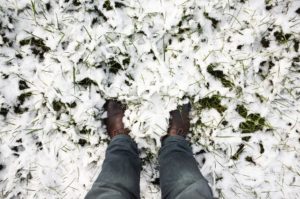
What can you do when lawn ice patches form? One thing to remember is to reduce foot traffic across the lawn.
During the depths of the winter season, ice, snow and sleet can fall and cover your landscape , lawns and gardens. There are different circumstances that may lead to ice patches forming, most often caused by poor lawn drainage. Frost can also cause ice patches to form and linger on your grass for several weeks. These patches damage your plants and can make your lawn slippery and hazardous. If you notice that ice patches have formed on your lawn and landscape, take these steps to minimize any potential damage.
Minimize Foot Traffic
Walking on snow-covered, fragile, dormant grass packs more snow onto the lawn, increasing the snow cover’s density and extending the melting time. The longer it takes the ice to melt, the more likely the snow will refreeze when temperatures drop at night. By reducing foot traffic across your lawn, you help the snow stay unpacked and it will melt faster. Encourage your family and friends to follow your sidewalks, pathways, and driveways when walking out.
Re-Grade Your Yard
If lawn ice patches regularly form every year, this may be due to poor lawn grading. Depending on the severity of the issues, you may want to schedule a re-grading of your lawn within the next year to prevent these ice patches from forming in the future. Why does lawn grading impact the ice on your lawn? Whenever the snow or ice melts, the water flows out and collects in your yard, potentially refreezing at night. Proper lawn grading ensures that the water does not collect in your yard or move back toward your house to cause leaks or flooding.
Break Lawn Ice Patches
Whenever sheets of ice form during a winter storm, they will thaw and refreeze—the denser the ice, the greater the potential landscaping damage. Tree limbs can also bend or break under heavy ice cover. You can break up these thick ice patches with a tool like a hammer. Breaking up the ice ensures faster melting. If there is heavy snow on your shrubs or trees, gently push off the snow with a broom before the snow can freeze. But be careful not to damage any limbs.
Melt the Ice Patches
You can use sand or even kitty litter to dissolve ice or snow that builds up on your pavement, walkways, and driveway. Avoid de-icing salt, as the melting snow can wash the salt off onto your yard, damaging your grass and plants.
Do not interfere with natural blankets of snow if they do not threaten your plants and their branches. Natural snow provides insulation, and as it melts, the water feeds the plants beneath.
Scientific Plant Service Is Your Go-To Source In Landscape Healthcare
Scientific Plant Service, located in Baltimore, is a privately owned corporation, chartered in Maryland in 1957 by Frank J. Burke. We started as a full-service Arborists specializing in the care of shade trees and ornamental shrubs, but today we are a Lawn Care company that is a huge part of the community. From aquatic environments and snow management to deer and mole control, SPS has services tailored specifically for your lawn and landscape.
We offer services in Maryland, Washington, DC, and Virginia, including: Harford, Baltimore, Carroll, Frederick, Howard, Anne Arundel, Montgomery, Prince Georges, Talbot, Queen Anne’s, Calvert counties in MD, as well as Loudoun County, Fairfax County, Arlington, Alexandria, and Falls Church in VA. For more information, contact us online, or call us at 410-321-0970. Be sure to follow us on Facebook, Twitter, LinkedIn, and Pinterest.

